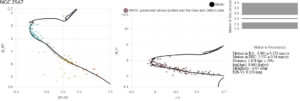NGC 2567 is an intermediate age, open star cluster located in the Puppis constellation, in the southern hemisphere of the celestial sky. It is located south of the Ecliptic. It was discovered by William Herschel on March 4th, 1793 and is located 1,677 parsecs from Earth.
A study by Juan J. Claria and Emilio Lapasset in 1983 determined that this cluster contains 3 red cluster giants. This study also concluded that this cluster has a short and relatively wide main sequence, and this main sequence largely contains late type-B, A, and F stars.
In order to study NGC 2567 and investigate the relationships between the colours, brightness, and the age and chemical composition of the cluster as a whole, I collected 15 images in filters with the Prompt-5 telescope at the Cerro Tololo Inter-American Observatory, in Chile, with total exposure durations of 70s, 40s and 20s in blue, green and red filters respectively, using Skynet between February 16th and 24th, 2023. I used Afterglow and Cluster Pro Plus to help analyze the spectrum of this cluster. And I found these basic results:
Distance: 1.87 kpc
E(B-V) Reddening: 0 (mag)
log(age): 8.61 (yr)
Metallicity: -0.07 (solar)
RA: -3.001 ± 0.223 (mas/yr)
Dec: 2.537 ± 0.36 (mas/yr)
The purpose of this study was to educate myself in the basics of spectrographic analysis as part of my astronomy education. I learned quite a bit about the tool Afterglow for manipulating and pulling data from images taken with optical telescopes, and the tool Cluster Pro Plus for analyzing these data. Interestingly, my cluster required no dereddening due to its E(B-V) value of 0. My analysis showed me that this cluster contains both red giants and blue stragglers. These red giants proved difficult to analyze as my isochrone fit of the data more closely matched the bottom of the cluster’s main sequence stars than an isochrone fit taken from data in the Milky Way Star Clusters Catalogue, but this catalogue had a better fit in regards to the red giants than my own.
This cluster was studied by Kharchenko et al (2013), who found parameters. I plotted the Gaia data with those parameters and found that this cluster has a lower metallicity than just the Kharchenko data implies.
It was a pleasure to learn these astronomical tools and take my own images of this beautiful cluster, and I am quite happy with my decision to enrol in this class as one of my science electives.
Below you will find the image I composited of NGC 2567, as well as the graphs I created of its spectrography.

